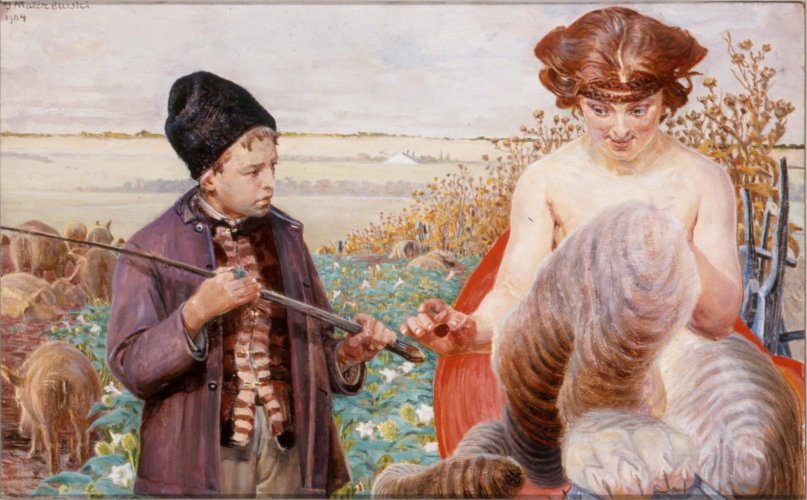Description:
Jack Malczewski (1854-1929) had a deep love for art and romantic literature, especially the poetry of Juliusz Słowacki, which he had inherited from his family home. He came from a noble, albeit poor, family. His father Julian supported him on his artistic career. The events of 1863, the January Uprising and subsequent repressions, left a deep mark on the young artist. His first teacher was Adolf Dygasiński. He spent his youth from 1867 to 1871 at his aunt and uncle’s estate in Wielgie. In 1873, he began his studies at the School of Fine Arts in Kraków under the tutelage of Jan Matejko. He was a student of Władysław Łuszczkiewicz. He also studied at the École des Beaux-Arts in Paris. He traveled to Italy, Vienna, Munich, Greece, and Asia Minor. From 1896 to 1900 and 1910 to 1914 he was a professor at the Academy of Fine Arts in Kraków. From 1912 to 1914 he was its rector. He started with idealizing realism, then naturalism, and the main theme of his works in this period was the fate of the exiles to Siberia and the inspiration of Juliusz Słowacki’s “Anhellim”. Fantastic and allegorical views began to appear in Malczewski’s work. After his father’s death in 1884, the recurring motif in Malczewski’s work was Thanatos – the god of death. After 1890, his art became completely symbolic. Works that manifested the shift towards a symbolist style were “Introduction” 1890, “Melancholy” 1890-1894, “Vicious Circle” 1895-1897. The artist addressed existential, historical and artistic topics, intertwining ancient and biblical motifs with native folklore and the Polish landscape so important in his works. Form, color, monumentalism of representations and their expressiveness became his trademarks.
Description of the painting:
The Chimera appearing on Malczewski’s paintings become the opposite of the often depicted protective angels in his paintings. They don’t inspire trust but rather unease. They can be interpreted as a reflection of the states of the human soul. Its body structure is remarkable. In “The Temptation of Fortune”, the stocky legs of the animal firmly anchor the Chimera to the bench or elevation on which it perched, close to the ground. At the same time, the wings that appear increase the impression of wanting to detach from it and soar through the sky. The duality and antagonism of these two parts become a kind of symbol of the artist’s inner conflict, forced to oscillate between necessity and duty and the vision of an idealistic art for art’s sake. This impression is further reinforced by the fact that the creatures belonging to the fantastic, unreal world usually appear in the context of scenes from everyday life, alongside people entangled in its prose *.
The Chimera-harpy of Malczewski from the waist down takes the form of a tiger, from the waist up it is a woman. Her back is adorned with a blood-red wings. There is nothing of a goat or a snake in it. In her right hand, outstretched towards the boy, she holds a coin. She looks at the boy with interest, waiting for his reaction.
The depicted half-human, half-animal figure becomes a personification of temptation, which can distract the creator with a false hope of easy enrichment, fame, often without the need for hard work. It entices his senses, poisons him, puts him in a state of hallucinatory, and thus false, vision of the goal of art and the painter’s duty. On the other hand, art itself becomes a temptation, enslaving the artist, who is so immersed in it that he cannot and does not want to resist its imaginings ****.


